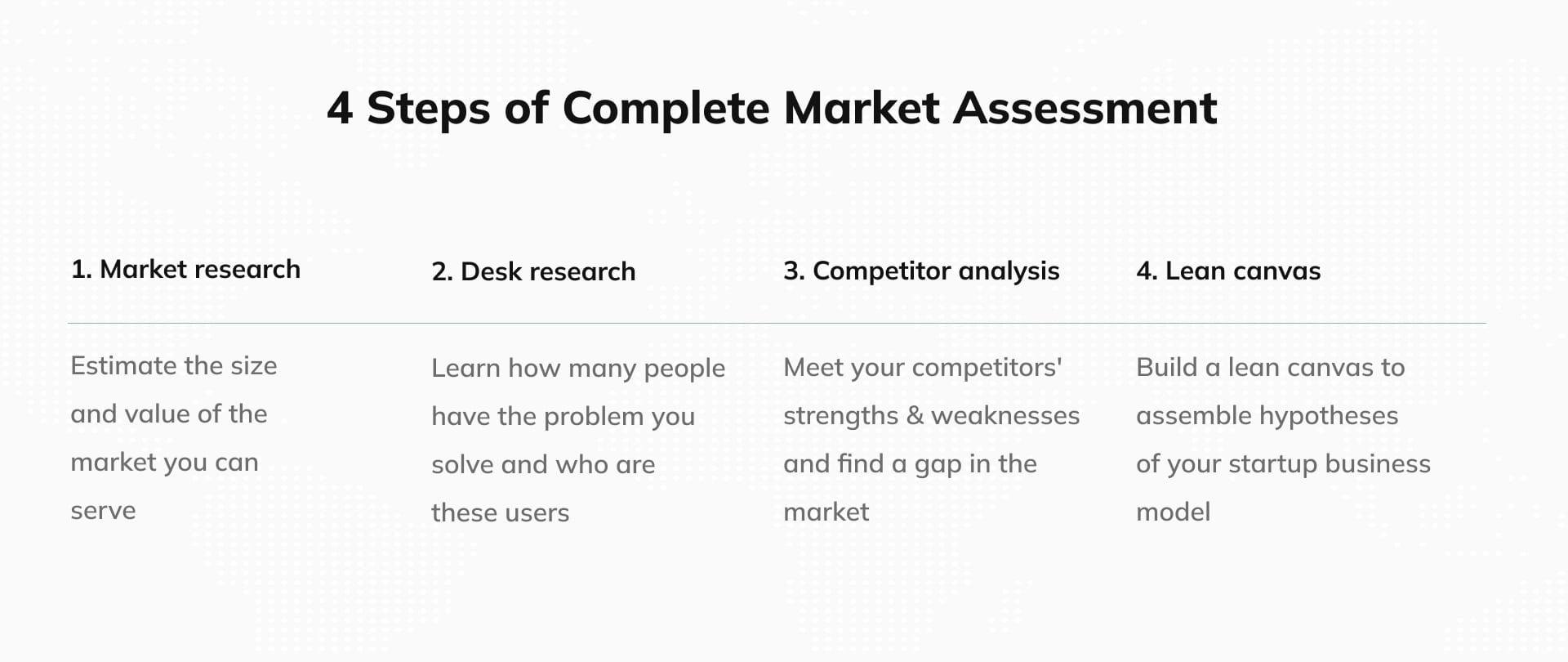The Four Steps You Need to Take Before You Start a Startup

It’s common for founders to fall in love with their startup idea from the very first moment. There’s nothing wrong with that as long as it’s preceded by accurate market assessment. In this article, we’ll guide you step-by-step through market potential evaluation to ensure your idea can succeed. Thanks to this framework, you can save time and money before you start product development.
Building a startup is a lengthy and costly process that often fails. Research shows that about 90% of startups fail. 10% of startups fail within the first year, but failure is most common for startups during years two through five, with 70% falling into this category. So what to do to minimize the risk of a fall? As you can guess, the key to success is proper preparation.
There are effective methods that allow us to verify whether our startup idea has a chance to be successful on the market. One of them is market potential research, which allows you to quickly and independently collect the necessary information from the market. In result it helps to verify whether the idea has a chance to find its way on the market.
Start with a comprehensive market assessment
It’s common for founders to start with the breakthrough idea first. This can result in them being biased and attached to their idea while conducting market research. In turn, this could lead to false outcomes that aren’t grounded in reality. As a result, a startup often cannot achieve product-market fit. It needs to be said that the market assessment is the process that will show if there is a niche in a given segment and where is the most significant potential for new product success. That is why we always recommend starting with the definition of the industry and market segment first and then verifying a hypothesis based on the market assessment results.
As part of the market potential research, it is possible to check the potential of the market segment, determine the size of the target group and check whether there are already competitive solutions on the market. Thanks to market assessment, we know what is happening in our target market and how strong the competition is. This allows them to reduce the risk of failure before investing significant funds.
Why is it important to get prepared before starting a startup?
If your idea potential is confirmed through market potential validation it will significantly facilitate product development. No matter if you are going to bootstrap your company or try to raise funding – in both cases, you will need to have such solid fundamentals. It gives the necessary set of arguments to build a team and talk to investment funds and agencies.
There are at least a few reasons to be prepared before starting a startup. Thanks to a well-conducted preparation phase you’ll be able to:
- validate hypotheses
- avoid costly failure
- attract business angels and investors
- efficiently develop products with an external agency
How to conduct market potential validation?
At Pragmatic Coders, we provide startup consulting services on a daily basis and advise on how to move from the idea phase to the execution phase. So far, we have helped over 60 startups in various stages of the development process. These experiences made us develop a rock-solid framework to help founders at the early stage of their business development.

It consists of 4 steps described in separate articles:
Step 1: Market research
Step 2: Desk Research
Step 3: Competitors analysis
Step 4: Lean canvas
The four steps to take before starting your startup
This practical and proven four-step discovery process will lead you to create an initial lean canvas, which is the basis for discussions with investors, contractors, and the team.
Step 1. Market Research
This is the first step that will help you to estimate the size and value of the market you can serve.

What is market research?
Market research is any set of techniques used to gather information and better understand a company’s target market. It is an essential tool for any business that wants to survive and thrive in today’s competitive landscape.
How to do market research
Market research combines primary and secondary research methods to gather data about our users and learn their preferences. Some of the sources of such information can come from:, we use publicly available data:
- available statistical data,
- reports from valuable sources,
- social media comments and discussion forums,
- user inveterviews outputs,
- surveys results,
- feedback from focus groups.
Why is market research necessary?
Thanks to market research, you can achieve significant data:
- Market size and product potential
- Total Available Market (TAM)
- Serviceable Available Market (SAM)
- Serviceable Obtainable Market (SOM)
- Market Growth Rate
- Avg spent per good sold
To perform market research properly, read “How to Conduct Market Research for your startup” – our second article in the “How to Start a Startup” series.
Step 2. Desk Research
The second step will show how many people have the problem you are solving and who these users are.

What is desk research?
Desk research is secondary research or documentary research. In contrast to primary research, where you collect data yourself, desk research focuses on analyzing data that someone has already researched before.
How to do desk research?
Desk research is a type of research that is based on the material published in reports and similar documents:
- Analysis of available statistical data, reports
- Analysis of threads and topics on various types of discussion forums
- Analysis of user reports on a given topic
- Content and content analysis
- Content analysis on YT, influencer content
Why is desk research necessary?
Thanks to desk research, you’ll be able to:
- Initial recognition of users’ needs
- Getting to know the business context of the project
- Gain a better understanding of the design problem
- Become familiar with the terminology and language of users
To dive deeper into desk research, read “How to Do Desk Research for Your Startup” – our second article in the “How to Start a Startup” series.
Step 3. Competitor Analysis
Thanks to the third step, you’ll explore your competitors’ strengths and weaknesses and find a gap in the market.

What is competitor analysis?
Competitors analysis helps to understand opportunities and limitations within your market better. The best businesses have differentiated products or services from the competition, allowing them to convey unique value to potential customers.
How to do competitor analysis?
There’s a few primary sources where you can search for competitors:
- Financial information of companies
- SEO tools like Semrush or Ahrefs
- Reports like Gartner or Forrester
- Google search
- Social media channels
- App stores or Google Play
- Tools like similarweb.com or alternative.net
Why is market competitor analysis critical?
Thanks to well-conducted competitor analysis, you’ll:
- Check if anyone has already created a product similar to yours
- Identify the differences between the existing solutions and your idea
- Find out if anyone has tried to do something like this in the past and with what effect
- Discover where are touchpoints with your possible competition
To make a comprehensive competitors analysis, read “How to Conduct a Competitor Analysis for Your Startup” – our third article in the “How to Start a Startup” series.
Step 4. Lean Canvas
The Lean Canvas is designed for startups and helps to assemble hypotheses of your startup business model to validate your concept.

What is a lean canvas?
Lean Canvas is a one-page business plan for any product idea. This is a simple but efficient way of describing the business model through 9 segments with essential aspects of your business.
How to do lean canvas?
To properly do lean canvas, you’ll need to fill nine boxes:
- Problem
- Customer Segments
- Key Metrics
- Solution
- Unique Value Proposition
- Unfair advantage
- Channels
- Revenue Streams
- Cost Structure
Why is lean canvas important?
Thanks to lean canvas, you’ll get a significant advantage:
- Systematizing the idea
- Assessment of the potential structure of costs and revenues
- Contribution to the development of the business model and pitch deck
To create a lean canvas efficiently, read “How to Create Lean Canvas for Your Startup” our fourth article in the “How to Start a Startup” series.
What are the next steps after market assessment?
The steps we have covered are only the minimum to determine if there is room for your idea in the market and how it looks compared to the competition. By assessing the market, you also gain hypotheses that shed light on possible products and customer needs.
In fact, your journey has just begun. Now you need to go a step further, collecting insights to shape your product and its functions, transferring it to wire flows, and
solutions with potential users. Finally, you also need to create an understandable business plan and a convincing pitch deck. But do not worry. We are on track to guide you through these steps.
Check other articles from our product-building series |




